- News
- Reviews
- Bikes
- Components
- Bar tape & grips
- Bottom brackets
- Brake & gear cables
- Brake & STI levers
- Brake pads & spares
- Brakes
- Cassettes & freewheels
- Chains
- Chainsets & chainrings
- Derailleurs - front
- Derailleurs - rear
- Forks
- Gear levers & shifters
- Groupsets
- Handlebars & extensions
- Headsets
- Hubs
- Inner tubes
- Pedals
- Quick releases & skewers
- Saddles
- Seatposts
- Stems
- Wheels
- Tyres
- Tubeless valves
- Accessories
- Accessories - misc
- Computer mounts
- Bags
- Bar ends
- Bike bags & cases
- Bottle cages
- Bottles
- Cameras
- Car racks
- Child seats
- Computers
- Glasses
- GPS units
- Helmets
- Lights - front
- Lights - rear
- Lights - sets
- Locks
- Mirrors
- Mudguards
- Racks
- Pumps & CO2 inflators
- Puncture kits
- Reflectives
- Smart watches
- Stands and racks
- Trailers
- Clothing
- Health, fitness and nutrition
- Tools and workshop
- Miscellaneous
- Buyers Guides
- Features
- Forum
- Recommends
- Podcast
review
£1,800.00
VERDICT:
Quick road bike that still offers plenty of comfort
Weight:
8,310g
Contact:
www.merida-bikes.com
At road.cc every product is thoroughly tested for as long as it takes to get a proper insight into how well it works. Our reviewers are experienced cyclists that we trust to be objective. While we strive to ensure that opinions expressed are backed up by facts, reviews are by their nature an informed opinion, not a definitive verdict. We don't intentionally try to break anything (except locks) but we do try to look for weak points in any design. The overall score is not just an average of the other scores: it reflects both a product's function and value – with value determined by how a product compares with items of similar spec, quality, and price.
What the road.cc scores meanGood scores are more common than bad, because fortunately good products are more common than bad.
- Exceptional
- Excellent
- Very Good
- Good
- Quite good
- Average
- Not so good
- Poor
- Bad
- Appalling
The Merida Ride 5000 is a quick road bike that offers plenty of comfort, splitting the difference between a standard race bike and an endurance bike.

Jump aboard the Ride 5000 and within yards you can feel a bit more give than you get from most road bikes. There's just a touch more movement at the saddle to cancel out all the little bumps and hollows in the road surface, and the big hits when you ride over a drain cover or pothole aren't quite as big any more.
In the short-term, that makes the ride feel pretty smooth, marked by an absence of rattle and chatter. Over the course of a long ride, the impression is that you stay ache-free for longer.
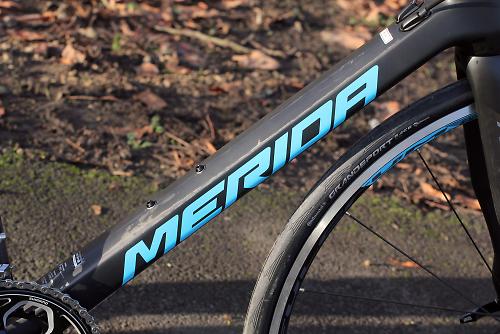
But don't get the impression that the Ride 5000 is a closely related to a beach cruiser, all plush comfort and to hell with speed. Far from it. Think of it as a race bike with a comfort edge, rather than as a comfort bike with a race edge.
When you want to kick the pace higher, the Ride 5000 is well up for it. Weighing in at 8.31kg (18.3lbs), it's not the fastest accelerator in the world but it doesn't hang about either with a very direct feel as soon as you turn up the wattage. It's a handy climber too. It doesn't exactly set the hills alight but I'm pretty sure that I never needed to go down into the titchy-tiny smallest gear (34-tooth chainring, 32-tooth sprocket) during testing.

Comfort
Most brands now have a range of pure race bikes in a low and stretched geometry, and a range of endurance bikes in a more relaxed geometry. Merida have the Reacto aero road bikes and the Scultura lightweight race bikes and then, on the endurance side, they have the Ride range.
The Ride 5000, though, splits the difference in terms of its geometry. The ride position isn't as short or as upright as it is on most of the other Ride models.

We have the 56cm model here that comes with a 598mm stack (vertical height between the middle of the bottom bracket and the top of the head tube) and a 382mm reach (the horizontal distance between those points). The equivalent measurements on the Reacto race bike are 578mm and 398mm while they're 611mm and 378mm on the other Ride models.
What that means in the real world is that the Ride 5000 puts you into a position that has half an eye on aero efficiency and half an eye on comfort. Personally, I don't like a bike that's too upright, but here I didn't feel like I was giving too much away through the position. It just took a little bit of strain off my lower back and I found myself using the FSA Gossamer handlebar's shallow drops more than usual. To me, that makes a lot of sense. Many people go for a pro setup and then spend their whole time on the hoods when they'd be better off going for a taller head tube and using the drops too.
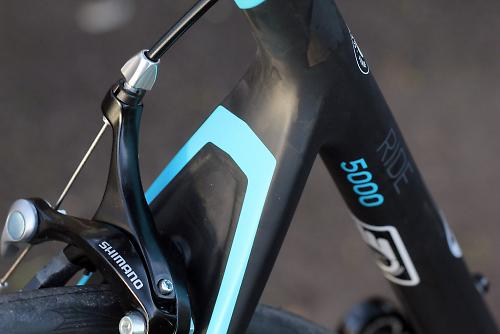
Anyway, the geometry is just one of the ways in which the Merida designers have added comfort here. There are many more.
The Flex Stay chainstays and seatstays, for example, are designed to absorb bumps and reduce vibration. The chainstays flatten as they move away from the bottom bracket. They look like they've been squashed down, the idea being to encourage up and down movement while retaining sideways rigidity. The profile of the seatstays is short and wide for the same reasons.

Merida say that they use bio flax fibres in the rear stays to dampen vibration further. Essentially, they add a central layer of this compound between layers of carbon-fibre in the mould.
The seatstays join the seat tube quite low, well below the top tube junction. Again, the design is intended to allow a little more vertical flex than would otherwise be the case. On top of that, Merida have used a skinny 27.2mm carbon seatpost and you're likely to have a lot of it extending out of the frame because the top tube slopes downwards along its length. Don't underestimate the difference a skinny seatpost makes. This definitely allows for quite a lot of saddle movement when you ride over lumps and bumps.

Merida slot their F-Flex fork in up front. Like the Flex Stays, it is shaped to mop up vibration, the lower half of the legs slimming down considerably over the upper sections. The fork, like the frame, features discreet mudguard mounts, by the way.
As well as all that, Merida fit 25mm tyres (although that's so common now that it hardly warrants a mention) and a Prologo Kappa 2 saddle with quite a bit of flex in the shell.
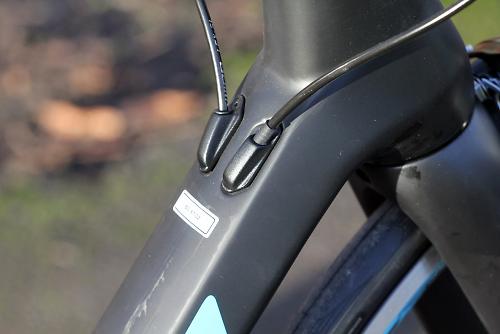
It's impossible to say how much most of those elements brings to the party. I suspect the skinny seatpost is more influential than any of the other features individually, but it's obviously not possible to fit a chunkier seatpost in there to find out for sure. The bottom line, though, is that the Ride 5000 offers an excellent ride quality that'll help you stay comfortable all day long when many other bikes would leave you feeling rattled.
Equally important, the up-and-down flex helps the Ride 5000 stay firmly in contact with uneven roads with none of that skittering about that you can get on some bikes. I found that I could retain plenty of control and continue pushing the pace over the rough stuff when others were reaching for the brakes.
The other stuff
Despite all this talk of comfort, the Ride 5000 is by no means a one trick pony. Put all of those comfort features to one side and this is still a very good bike.

For a start, it comes equipped with Shimano's Ultegra shifters and mechs. Go to our full review of that groupset for all the details on those. In short, they perform superbly, even when you're shifting under load.
You don't get a full Ultegra groupset by any means. The brakes, for example, are Shimano R561s; they don't belong to any groupset. They're dual pivot and they work well on the aluminium braking surfaces of the Fulcrum Racing PRC wheels, giving you enough faith to head quickly into greasy, winding descents knowing that they'll perform forcefully when you need them.

The chainset is a pretty basic looking Shimano RS500 compact, with 50-tooth and 34-tooth chainrings, but, again, it does a good job. The cassette is an 11-32-tooth unit. The downside of such a wide-ranging cassette is that you get some big jumps in gear ratios that can upset your rhythm, but sling the chain on the inner chainring and that big sprocket and you get a fun-size gear that might come in handy when your muscles have shut up shop for the day.
The Fulcrum Racing PRC wheels aren't especially light but they have stayed round and true throughout testing. Despite the fact that these are solid rather than spectacular wheels, the Ride 5000 responds obediently when you put down the power. It might not quite keep pace with more lightweight rivals in a sprint but it'll chomp away at the miles with the best of 'em when you get down on the drops and put in the work.
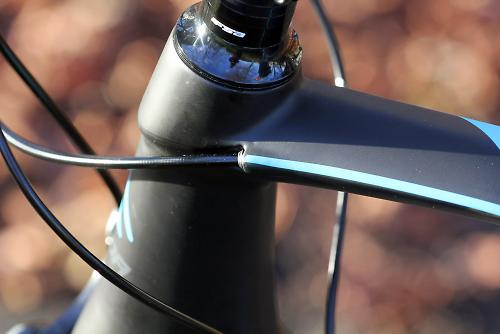
Overall, I found the Merida Ride 5000 to be a really likeable bike. If I'm honest, I was expecting it to be quite staid, perhaps even (whisper it) a little dull, but that really isn't the case. Merida call this bike a 'comfort racer' and that's a very good description. They've taken speed from a race bike and blended in comfort from an endurance bike to come up with something that's the best of both worlds.
Verdict
Quick road bike that still offers plenty of comfort
road.cc test report
Make and model: Merida Ride 5000
Size tested: 56cm
About the bike
State the frame and fork material and method of construction. List the components used to build up the bike.
FRAME Ride CF3, internal cable routing, Di2 compatible
FORK Road carbon Race-Sport flex
DERAILLEUR FRONT Shimano Ultegra D
DERAILLEUR REAR Shimano Ultegra GS
SHIFTERS Shimano Ultegra
BRAKES Shimano R561
CHAINSET Shimano RS500 50-34
CHAIN Shimano 11s
RIM Fulcrum Racing PRC
FREEWHEEL Shimano CS-5800-11 11-32
TYRES Continental Grand Sport Race 25 fold
STEM Merida Pro CF OS -5
HANDLEBAR FSA Gossamer compact OS
HEADSET Big Conoid S-bearing neck pro
SEATPOST MERIDA carbon H SB15 27.2
SADDLE Prologo Kappa 2
Tell us what the bike is for, and who it's aimed at. What do the manufacturers say about it? How does that compare to your own feelings about the bike?
Merida call their Ride bikes 'comfort racers' and that's a valid description, especially of the Ride 5000 with a slightly less relaxed geometry than that of the bikes further down the range.
They say: The ultimate comfort option in our carbon Ride range.
Comfort is a tricky word - we all want it, but it sounds a very soft and dull word.
The Lampre Merida team have a 'comfort' bike - designed to be used on the cobble stones of Paris Roubaix (The Hell of the North). A bike that can be raced on that terrain must be incredibly strong, but also keep the rider in good shape by being very forgiving.
You will see plenty of marketing for cheap carbon frames, there are masses of them on the market.
But the important thing about carbon engineering is knowing what forces are at play in the frame (these are many and varied) and working out which fibres to use and in which direction they should be aligned.
The carbon lay-up schedule includes the highest quality fibres appropriate for their individual purpose. So that means we don't claim Ultra High Modulus frame, as there will be a huge a variety of fibres used.
Stiff fibres (high modulus) are needed to create stiff areas such as around the bottom bracket, and lower modulus fibres are needed for comfort, for example in the seat stays.
Frame and fork
Overall rating for frame and fork
8/10
Riding the bike
Rate the bike for efficiency of power transfer:
8/10
Rate the bike for acceleration:
7/10
Rate the bike for sprinting:
7/10
Rate the bike for high speed stability:
8/10
Rate the bike for cruising speed stability:
8/10
Rate the bike for low speed stability:
8/10
Rate the bike for flat cornering:
8/10
Rate the bike for cornering on descents:
8/10
Rate the bike for climbing:
7/10
The drivetrain
Rate the drivetrain for performance:
8/10
Rate the drivetrain for durability:
8/10
Rate the drivetrain for weight:
8/10
Rate the drivetrain for value:
8/10
Wheels and tyres
Rate the wheels and tyres for performance:
7/10
Rate the wheels and tyres for durability:
8/10
Rate the wheels and tyres for weight:
7/10
Rate the wheels and tyres for comfort:
8/10
Rate the wheels and tyres for value:
8/10
Controls
Rate the controls for performance:
8/10
Rate the controls for durability:
8/10
Rate the controls for weight:
8/10
Rate the controls for comfort:
8/10
Rate the controls for value:
8/10
Your summary
Did you enjoy riding the bike? Yes, I was surprised at how much I enjoyed this bike.
Would you consider buying the bike? If I was in the market for a bike of this type I'd consider it.
Would you recommend the bike to a friend? Yes.
Rate the bike overall for performance:
8/10
Rate the bike overall for value:
8/10
Anything further to say about the bike in conclusion?
Merida describe this bike as a 'comfort racer' and that's exactly right. It offers an appealing blend of speed and comfort.
About the tester
Age: 43 Height: 190cm Weight: 75kg
I usually ride: My best bike is:
I've been riding for: Over 20 years I ride: Most days I would class myself as: Expert
I regularly do the following types of riding: commuting, club rides, sportives, general fitness riding,
Mat has been in cycling media since 1996, on titles including BikeRadar, Total Bike, Total Mountain Bike, What Mountain Bike and Mountain Biking UK, and he has been editor of 220 Triathlon and Cycling Plus. Mat has been road.cc technical editor for over a decade, testing bikes, fettling the latest kit, and trying out the most up-to-the-minute clothing. He has won his category in Ironman UK 70.3 and finished on the podium in both marathons he has run. Mat is a Cambridge graduate who did a post-grad in magazine journalism, and he is a winner of the Cycling Media Award for Specialist Online Writer. Now over 50, he's riding road and gravel bikes most days for fun and fitness rather than training for competitions.
Latest Comments
- Born_peddling 4 hours 3 min ago
Muddyfox tour 100's I've wide & flat feet plus there's the optional choice of using cleats with them...
- Prosper0 3 hours 58 min ago
Just doing the Lord's work in case anyone's interested in this product. This Mucoff Pump is a £100 rebrand of an £85 Rockbros rebrand of a £60...
- mdavidford 4 hours 42 min ago
You forgot ignoring half the race to show awkward interviews with the riders' Proud Parents™ instead.
- mdavidford 4 hours 46 min ago
Obviously it means 'springing out of the bunch' on a critical sector. Or maybe it's referring to the time of year.
- David9694 5 hours 33 min ago
Car crashes through garden wall for second time in 18 months https://www.wiltshire999s.co.uk/car-crashes-garden-second-time/
- David9694 5 hours 35 min ago
Woman taken to hospital after flipping car onto roof in Trowbridge...
- A V Lowe 6 hours 17 min ago
Its blindingly obvious from the image that the DKE of the buses include the mirrors which extend to nearly reach the edge of the tarmac pavement on...
- Sredlums 6 hours 50 min ago
It's sad when being very good at your job - any job - isn't enough to earn a decent living. It shouldn't be that way....























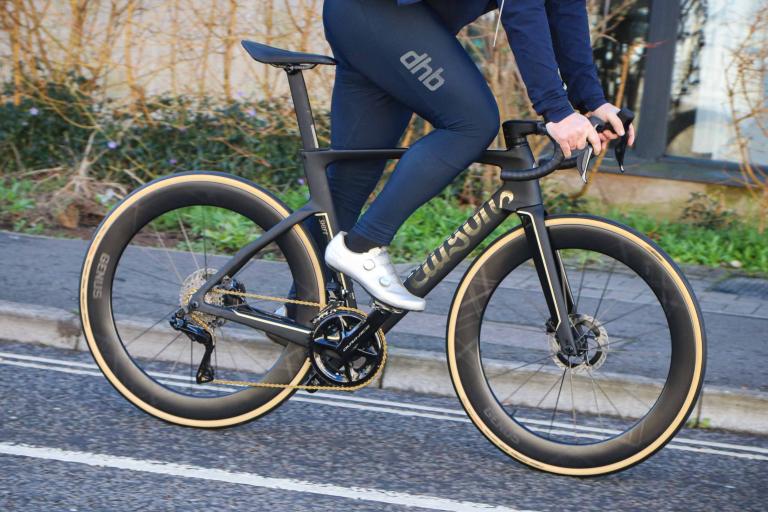
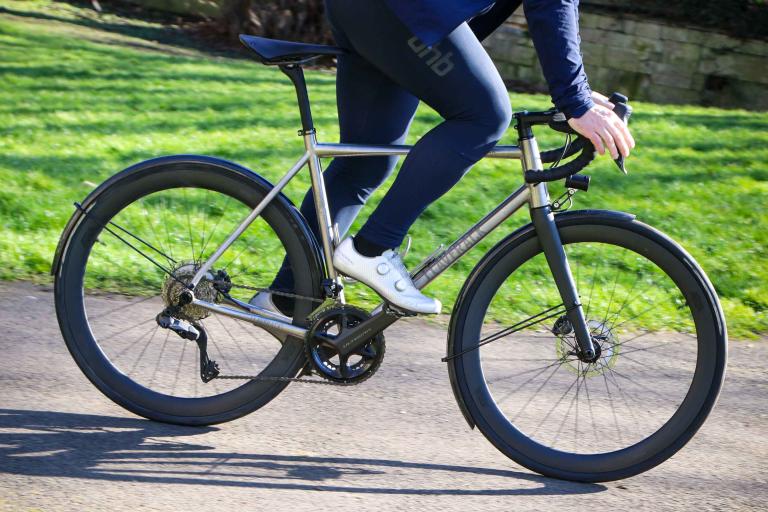

Add new comment
4 comments
I recall the first generation of compact frames, the Giant TCRs, and riding behind people who bought them revealed a seat post that swayed with the pedalling action. I think seatposts move a bit more than we think.
Do skinny seatposts really make much of a difference? The seatpost is almost vertical, so when taking a hit the seatpost undergoes a compression force- and none of the materials built for seat posts compress very much at all.
Frame geometry looks great,but if the weight 8.31KG is without pedal,not too fine...
I love comments like this because it strikes me they are often made by people missing the point of the bike. This is a bike for riding swiftly over long distance in a bit more comfort than a race bike, so out and out low weight isn't as crucial.
If it's out and out low weight you want, get an out and out climbing bike. If it's aero you want, or a little more comfort, but still want a bike that stiff laterally, you will either have to put up with extra weight or shell out a shed load of extra cash.
Whats the point of having a bike that weighs the same as a feather but flops around all over the place (was riding being someone recently who's bike weight was 6.8kg, and it cost him £1800, but there was very obvious sideways flex with each pedal stroke, so half his effort was just going into flexing the bike beneath him).